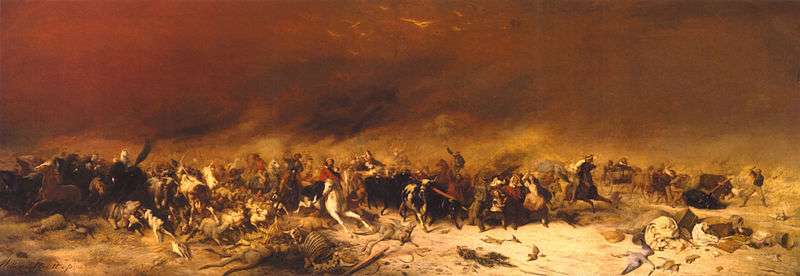William Strutt
| William Strutt | |
|---|---|
 Self portrait of Strutt, 1845 | |
| Born |
3 July 1825 Teignmouth, Devon |
| Died |
3 January 1915 Wadhurst, Sussex |
| Nationality | English |
William Strutt RBA, FZS (3 July 1825 – 3 January 1915) was an English artist.[1]
Strutt was born in Teignmouth, Devon, England, and came from a family of artists, his grandfather, Joseph Strutt, was a well-known author and artist, his father, William Thomas Strutt, was a good miniature painter. William Strutt enjoyed a student life in Paris, France, and England, studying figurative and history painting. In response to a near-breakdown and problems with his eyes, Strutt decided to visit Australia, arriving 5 July 1850 on the Culloden, where he then married.
In Melbourne, Strutt found employment as an illustrator on the short-lived Illustrated Australian Magazine, published by Thomas Ham, as there was little demand for the figurative and history paintings for which he was trained. Some of his designs did, however, lead to commissions, including a design for a new postage stamp, and an Anti-Transportation League card. Despite the lack of interest for major history paintings in Melbourne, Strutt continued to sketch suitable subjects, including the ‘Black Thursday’ bushfires, which swept over the colony on 6 February 1851. It was from these sketches that Strutt composed one of his most notable paintings some 10 years later, Black Thursday, 6 February. 1851, 1864, which depicted animals and men fleeing from the fire.
In February 1852, Strutt joined the growing tide of men travelling to the gold-fields surrounding Ballarat, Victoria. Despite working in the gold fields for eighteen months he found little success. He returned to Melbourne in mid-1853 and became actively involved in the city’s cultural scene, undertaking a number of portrait commissions and joining the Victorian Society of Fine Arts as a founding member.
Strutt’s interest in depicting the notable events of the colony was piqued by the events surrounding the Victorian Exploring Expedition led by Burke and Wills in 1860–61. He made several studies of their preparations at Royal Park, Melbourne, and followed the expedition to its first camp at Essendon, Victoria. Strutt also collected first-hand accounts from the rescue party and from John King, the expedition's sole survivor, upon his return.
Strutt left the colony of Victoria in 1862. A highly religious man, he dreaded bringing up his children in what he perceived to be a godless society. Returning to England where he completed two major works based on Australian sketches, Black Thursday, 6 February 1851 and Bushrangers, Victoria, Australia, 1852. He continued to draw on his Australian sketches to produce major oil paintings, including The Burial of Burke. In 1861, he painted imagined scenes from the First Taranaki War based on sketches that he made during him time in New Zealand from 1855 to 1856. The painting View of Mt Egmont, Taranaki, New Zealand, taken from New Plymouth, with Maoris driving off settlers' cattle, was purchased by the Museum of New Zealand Te Papa Tongarewa in 2015 from the John Lawford Collection for NZ$1.5 million; it is the only significant oil painting from the 1850s or 1860s held by New Zealand's national museum.[2]
William Strutt died in Wadhurst, Sussex, England on 3 January 1915.
Gallery

 Black Thursday, February 6th. 1851, 1864, State Library of Victoria
Black Thursday, February 6th. 1851, 1864, State Library of Victoria David's first victory, 1868, Art Gallery of New South Wales
David's first victory, 1868, Art Gallery of New South Wales Jerusalem pilgrims, 1872, Art Gallery of South Australia
Jerusalem pilgrims, 1872, Art Gallery of South Australia The Prior's Feast, 1915
The Prior's Feast, 1915
See also
Publications
- William Strutt, The Australian journal of William Strutt, A.R.A., 1850–1862 (Sydney?: s.n., 1958).
- Heather Curnow, The life & art of William Strutt, 1825–1915 (Martinborough, N.Z.: Alister Taylor, 1980).
- William Strutt, Victoria the golden: scenes, sketches and jottings from nature, 1850–1862 (Melbourne: Library Committee, Parliament of Victoria, c1980).
- William Strutt, Cooey, or, The trackers of Glenferry (Canberra: National Library of Australia, 1989).
References
- ↑ "Strutt, William". Who's Who. Vol. 57. 1905. p. 1555.
- ↑ Edwards, Jessy (27 October 2015). "Te Papa buys 'powerful moment'". The Press. p. A4. Retrieved 6 November 2015.
- Serle, Percival (1949). "Strutt, William". Dictionary of Australian Biography. Sydney: Angus and Robertson.
- Marjorie J. Tipping, 'Strutt, William (1825–1915)', Australian Dictionary of Biography, Volume 6, MUP, 1976, pp 210–211.
External links
| Wikimedia Commons has media related to William Strutt. |
- Strutt's works in the National Library of Australia, Canberra
- Strutt's work in the Picture Australia database
- Judy Cannon, ‘The artist who painted words’, NLA News, August 2004, Volume XIV, Number 11
- Heather Curnow, The New Zealand Paintings of William Strutt
- Black Thursday Online version of the original painting and a soundscape.